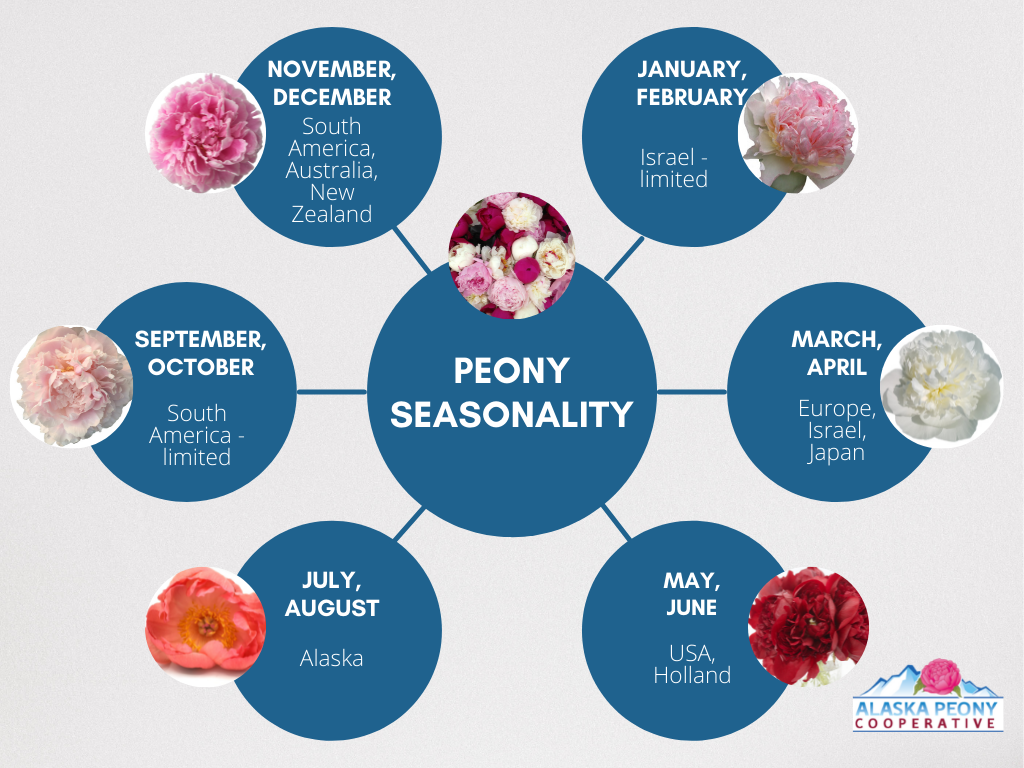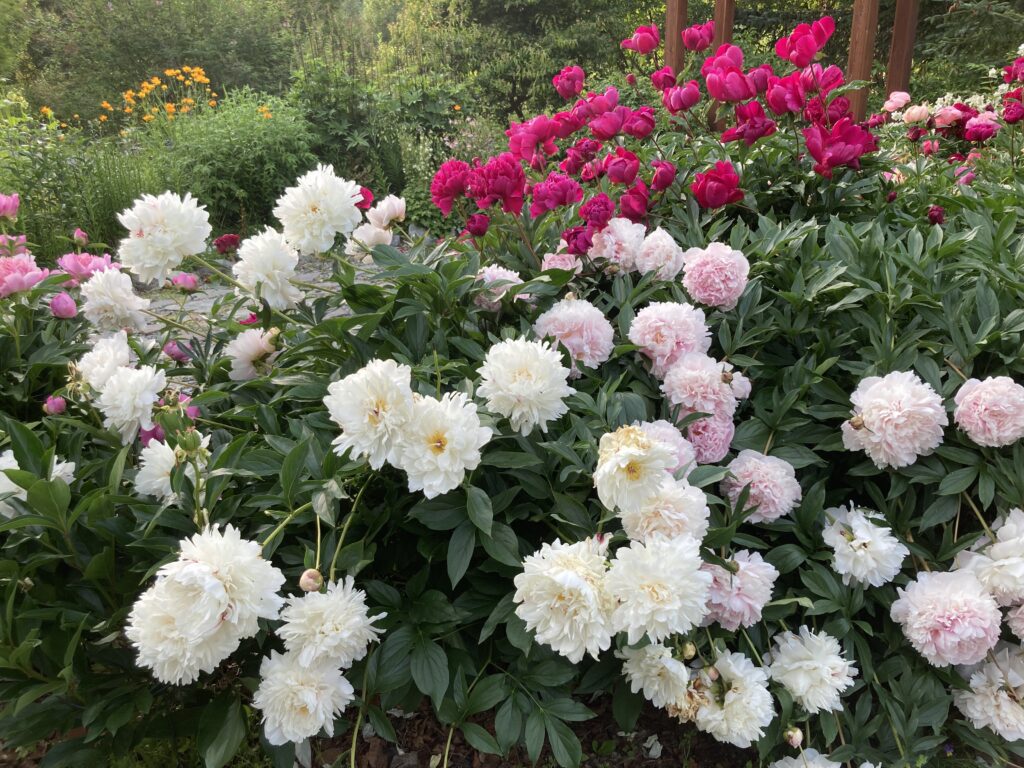Peony Seasonality and Extended Bloom Time
There is no doubt that peonies are one of the most beloved flowers. Used as a cut flower in the most important ceremonies across the world, and grown as the crown jewel in the most humble garden peonies are celebrated around the globe. But with a relatively short bloom season, peonies leave the world yearning for more. Originally native to the Northern hemisphere, peony cultivation has spread across the globe to close the gaps in the worldwide supply of peonies as cut flowers. Combined with a reliable transportation network, peonies are now more available than ever before, with only a few short holes in the supply chain.
World Peony Supply

The world’s largest peony producers span the globe as spring makes its way through both hemispheres and includes; The Netherlands, Europe, Australia, New Zealand, The United States, Israel, Chile and more recently, Alaska. January, September and October are the most difficult months to source peonies, but with a little research and a good flower importer peonies can be shipped nearly year round.
Shipping peonies from across the globe is standard practice for those in the floral industry, but for home gardeners it is possible to gain an extra week or two of bloom time with careful consideration of some specific cultivar and planting factors.
Long Term Storage
Peonies do exceptionally well with a limited amount of long term cold storage. Stored dry at 33 – 34 degrees, peonies can hold for approximately 5 weeks with little, to no noticeable difference. Some varieties store better than others, typically those with a higher petal count can be stored longer than varieties with a low petal count. Some producers are able to hold peonies for much longer, pushing 12 weeks in a high-tech climate controlled environment. Low oxygen totes in the Netherlands produce the most reliable peonies from long term storage.

What to Expect
Peonies are best stored dry for the long term. That means from the moment they are cut in the field until they are ready to be used there is no water available for the flower to soak up. If a peony is stored in water, even while in cold storage, it will continue to bloom. If you are only holding the stems for a week this is not a problem. But if you would like to hold them for longer they will need to be stored without water. They can be stored standing up in buckets and totes, or laying down in boxes or crates.
When peonies have been stored for five or more weeks they will start to show signs of age. The foliage may not perk up as well, the bloom may open slower and not as full, the petals may appear crinkly or wrinkled. The fragrance is also diminished and vase life will be shorter. There may even be spots of mold at the base of the bud. Plants that are forced into an unnatural bloom time may produce smaller buds. Depending on the number of times in transit and the temperature of the box while in transit, these changes may be more obvious as they near the five week mark. With so many unknown variables it makes shoulder season peonies a bit unreliable.
It is important the consumer is educated on the seasonality of peonies across the world to avoid surprises when the box arrives. Shoulder season peonies will be more expensive and may not have the quality that is expected. Strive to always source peonies when they are in peak production in each growing zone for the most reliable and stunning flowers.
Bottom Line
The most important thing to remember is that peonies are a spring bloom. And although commercial growers do their best to extend the season with high tech cold storage techniques, planting high on mountain sides, or attempting to artificially control growing conditions, high quality peonies are not available year-round. It is best to always choose seasonal flowers, purchased directly from the grower because you can ask how long they’ve been stored. Working with a wholesaler that is familiar with the global supply chain of peonies and storage practices will also be instrumental in sourcing peonies when you aren’t quite sure how long they have been in production in each growing region.

Factors Influencing Peony Bloom Time in the Home Garden
As a home gardener, or farmer florist, with careful consideration during your planning phase of choosing which peonies to plant, and where, it is possible to slightly extend the blooming season. There are three main types of peonies; herbaceous, tree and itoh, or intersectional. Depending on your growing zone you may want to consider having a mix of all three types to extend the bloom time.
Herbaceous Peonies
Easily the most popular type of peony in both the cut flower industry and what is available for purchase at your local garden center when looking for bare roots or full plants. However, this is not the longest blooming type of peony. You can carefully select early, mid and late season blooming varieties to get the most flowering time, but even with the most meticulous planning Mother Nature has a way of blending all varieties into two short weeks. Most varieties only bloom an average of 7-10 days. Herbaceous peonies are great if you are looking for early summer bloomers and are hardy from zones 3 through 8 making them an excellent all around choice.


Tree Peonies
If you are growing in zones 4 through 9, adding several varieties of tree peonies to your collection would bring in the earliest blooming peonies with the added bonus of foliage and woody branches that stay year round rather than dying back in the fall. Tree peonies tend to bloom in late spring, usually before the herbaceous varieties start to flower. Another benefit of this variety is that tree peonies do not need as long, or as cold of a winter dormancy period making them perfect for mild winter climates. Unfortunately, this same feature makes them a poor choice for growers in Northern latitudes such as Alaska.

Itoh, or Intersectional Peonies
A cross between tree and herbaceous varieties, Itoh peonies bring us the best qualities of each but with a few additional bonuses. Itoh varieties are some of the most prolific and largest blooming peonies. They bloom the latest out of all three types with a 3-4 week blooming period lasting well throughout the mid-summer months. The roots also have a greater tolerance for warm climates and do not require a long, frigid dormant season making Itoh varieties perfect for warmer climates in zones 7 through 9.

Cutting and Chilling Buds
Clipping a few stems in bud stage, wrapped in dry paper and a loose plastic sack before placing in a home refrigerator is another method to keep peonies around just a little bit longer. Clip the stem when the bud has some give to it, but not squishy. Think of it as a memory foam mattress, some softness but still quite firm. If dry stored in your home refrigerator, remember to keep it away from fruits and vegetables. Pulling a few stems out every couple of days for up to two weeks is easy enough, even a novice should have success with this method.

Enjoying The Moment
Perhaps the allure of peonies is the fact that they are so short lived. But we can all agree that days spent enjoying peonies, no matter how few, are good days. Incorporating a couple of these tips into your garden, and knowing the seasonality across the globe should help bring you more days with these beautiful flowers. For those of us lucky enough to have a friend in the floral business we may even be blessed with peonies from other countries. Make friends with your local floral designer and your heart will always be full.
-Written by the Members of the Alaska Peony Cooperative

